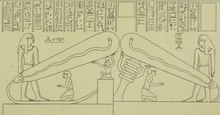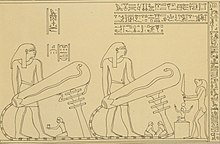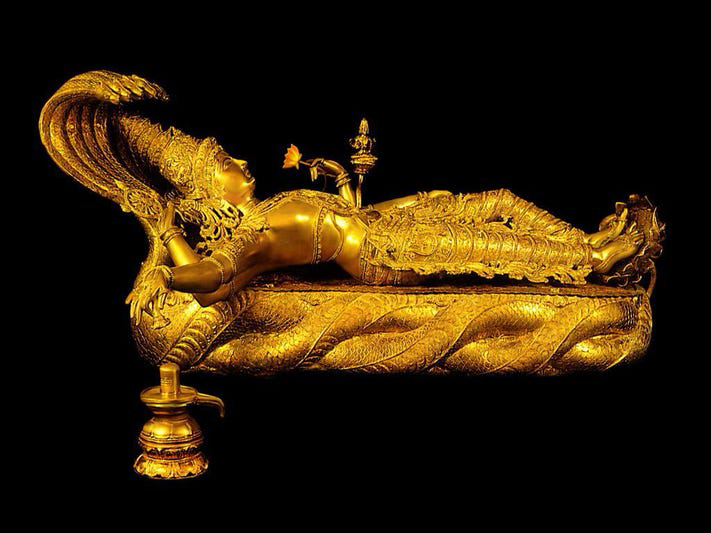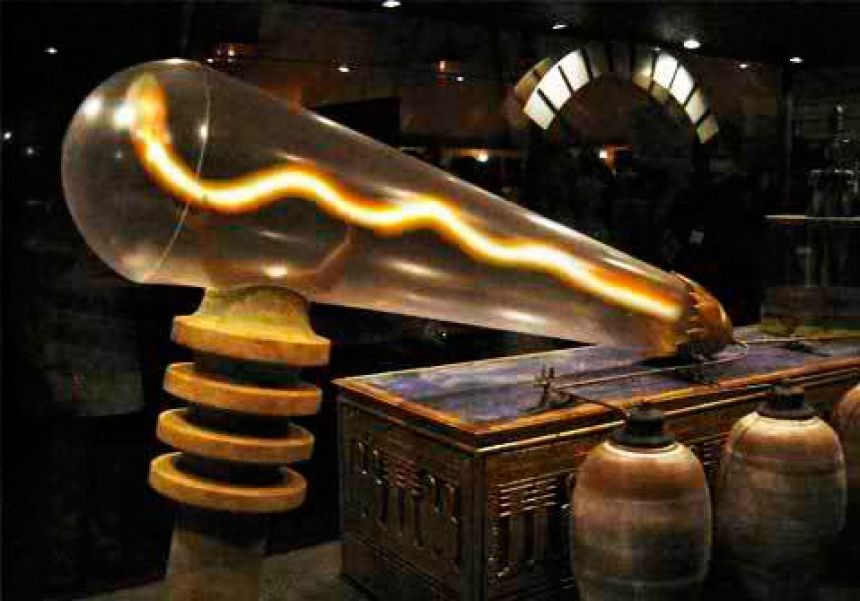It looks like you're using an Ad Blocker.
Please white-list or disable AboveTopSecret.com in your ad-blocking tool.
Thank you.
Some features of ATS will be disabled while you continue to use an ad-blocker.
share:
originally posted by: visitedbythem
a reply to: Ravenwatcher
The relief carvings depict a giant lotus flower with the god Harsomtus arising in the form of a serpent from it, surrounded by a bubble of magical energy. In two of the three carvings, the energy bubble emerging from the lotus flower is held up by a miniature male figure dressed in a loincloth with a sun disk on its head. In all three carvings, a full-sized male figure in a loincloth stands behind the lotus flower.
Many people are convinced that these reliefs from the southern crypt of the Temple of Hathor at Dendera depict incandescent lightbulbs. They think that the stem of the lotus flower is an electrical wire, that the magical bubble around the serpent is the glass bulb, and that the serpent itself is the filament. This, however, is, quite frankly, an absurd interpretation. It is the sort of interpretation that I would normally assume to be satirical, but yet there are many people who are firmly convinced that it is correct.
If you look at the reliefs carefully, you will notice that there are a lot of obvious signs that should tip you off that they are not depictions of incandescent lightbulbs. For one thing, in all three reliefs, the snake quite clearly has eyes and a mouth. The lotus flower the snake is emerging from quite clearly has petals. It is also worth noting that the filament in an incandescent lightbulb is actually a horizontal wire running between two vertical supply wires. The filament has to be connected to a wire on both sides or it will not produce light. The snake in the relief carvings from Dendera, however, is only attached to lotus flower by its tail; its head is not attached to anything.
There is really nothing in the relief carvings from Dendera that can be sensibly interpreted as looking anything more than extremely vaguely like a modern incandescent lightbulb—or any other kind of lightbulb. Furthermore, the scene from Dendera actually depicts a well-attested scene from Egyptian mythology. The story of Harsomtus coming forth from the primordial lotus flower is well-known from surviving Egyptian texts.
...or, it could be this ^^^^^^
I don't see why this is supposed to depict lifting stones. I don't see any stones being lifted.
What I see is a vehicle coming in for a landing. The Animal dude on the right is holding up two traffic guides as if he is directing them onto the runway for either a landing or a take-off.
The other animal dude on the left seems to be operating the gas-powered air ship that the passengers (humans) are riding in.
Seems to me that they had human-animal hybrid slave labor back then. Maybe these human-animal hybrids were the ones who actually did the heavy lifting?
What I see is a vehicle coming in for a landing. The Animal dude on the right is holding up two traffic guides as if he is directing them onto the runway for either a landing or a take-off.
The other animal dude on the left seems to be operating the gas-powered air ship that the passengers (humans) are riding in.
Seems to me that they had human-animal hybrid slave labor back then. Maybe these human-animal hybrids were the ones who actually did the heavy lifting?
Now explain the duel chef knife wielding monkey and we might be onto something.
a reply to: Ravenwatcher
a reply to: Ravenwatcher
edit on 14-10-2022 by Athetos because: (no reason given)
a reply to: Ravenwatcher
IF, you were an Egyptian how would you depict Electricity in pictorial form. For a start if you touch an electrical connection it "bites" you like a snake and if you see static electricity it writhes like a snake.
IF, you were an Egyptian how would you depict Electricity in pictorial form. For a start if you touch an electrical connection it "bites" you like a snake and if you see static electricity it writhes like a snake.
Another idea is that this thing is literally the Ark of the Convenient. And what we are seeing in the illustration is one of the 'gods' themselves.
Encapsulated in their safety dome. Our god, the snake god, from our serpent overlord, that controls all of humanity, and is trying to build a wall
between his people (us) and the Intergalactic Federation of Light (God).
Yes? No?
Yes? No?
It's a swedish made enlarger. Not that I'd know... not my bag, baby.
Can anybody here independently read the hieroglyphs at these sites?
It seems to read ftom bottom to too from a western viewpount as the tools in the monkeymans hands are depicted at thd top.
Fascinating subject.
It seems to read ftom bottom to too from a western viewpount as the tools in the monkeymans hands are depicted at thd top.
Fascinating subject.
Fact check. That's what I get for going off memory. Visitedbythem has a better answer.
Looking into it. It's one of six objects that depict the creation story in The Temple of Hathor at dendara.
They translated all the hieroglyphs and images to say this, as transcrtibed directly from Wikipedia.
Object 1 & 2:

Left:
Speaking the words of Harsomtus, the great God, who dwells in Dendera, who is in the arms of the first in the night-barge, sublime snake, whos Chentj-statue carries Heh, whos crew carries in holiness his perfection, whos Ba caused Hathor to appear in the sky, whos figure is revered by his followers, who is unique, encircled by his forehead-snake, with countless names on the top of Chui-en-hesen, the symbol of power of Re in the land of Atum (Dendera), the father of the Gods, who created everything.
Right:
Speaking the words of harsomtus, the great God, who dwells in Dendera, the living Ba in the lotus flower of the day-barge, whos perfection is carried by the two arms of the djed-pillar as his Seschemu-image, while the Kas on their knees bend their arms.
Object 3:

Speaking the words of harsomtus, the great God, who dwells in Dendera, who emerges out of the lotus flower as a living Ba, whos completeness is elevated by the Kematju-images of his Ka, whos Seschemu-image is revered by the crew of the day-barge, whos body is carried by the djed-pillar, underneath his Seschemu-image is the Primal and whos majesty is carried by the companions of his Ka.
Object 4:

Harsomtus in the hn-container of the night-barge that contains four figures. The figure of heh is in front of him, whereas this flower is behind him, the water beneath him.
Objects 5 & 6:

Left:
Harsomtus on his barge
Right:
Harsomtus of Upper- and Lower Egypt, the Sata-snake, that emerges from the flower, which contains the hn-container, who is flanked by four figures with human faces, under his head the figure of Heh on the Serech on the bow of his barge. The Juf-monkey with the face of a toad, armed with knives, is in front of him, as are the two figures that carry the front part of this flower.
Looking into it. It's one of six objects that depict the creation story in The Temple of Hathor at dendara.
They translated all the hieroglyphs and images to say this, as transcrtibed directly from Wikipedia.
Object 1 & 2:

Left:
Speaking the words of Harsomtus, the great God, who dwells in Dendera, who is in the arms of the first in the night-barge, sublime snake, whos Chentj-statue carries Heh, whos crew carries in holiness his perfection, whos Ba caused Hathor to appear in the sky, whos figure is revered by his followers, who is unique, encircled by his forehead-snake, with countless names on the top of Chui-en-hesen, the symbol of power of Re in the land of Atum (Dendera), the father of the Gods, who created everything.
Right:
Speaking the words of harsomtus, the great God, who dwells in Dendera, the living Ba in the lotus flower of the day-barge, whos perfection is carried by the two arms of the djed-pillar as his Seschemu-image, while the Kas on their knees bend their arms.
Object 3:

Speaking the words of harsomtus, the great God, who dwells in Dendera, who emerges out of the lotus flower as a living Ba, whos completeness is elevated by the Kematju-images of his Ka, whos Seschemu-image is revered by the crew of the day-barge, whos body is carried by the djed-pillar, underneath his Seschemu-image is the Primal and whos majesty is carried by the companions of his Ka.
Object 4:

Harsomtus in the hn-container of the night-barge that contains four figures. The figure of heh is in front of him, whereas this flower is behind him, the water beneath him.
Objects 5 & 6:

Left:
Harsomtus on his barge
Right:
Harsomtus of Upper- and Lower Egypt, the Sata-snake, that emerges from the flower, which contains the hn-container, who is flanked by four figures with human faces, under his head the figure of Heh on the Serech on the bow of his barge. The Juf-monkey with the face of a toad, armed with knives, is in front of him, as are the two figures that carry the front part of this flower.
edit on 14-10-2022 by Degradation33 because: (no reason
given)
That sounds like a plausible explanation.
Could that be real, a creation myth or a way for a more primative people to understand something they happened upon tho?!
a reply to: visitedbythem
5
Could that be real, a creation myth or a way for a more primative people to understand something they happened upon tho?!
a reply to: visitedbythem
5
originally posted by: visitedbythem
a reply to: Ravenwatcher
The relief carvings depict a giant lotus flower with the god Harsomtus arising in the form of a serpent from it, surrounded by a bubble of magical energy. In two of the three carvings, the energy bubble emerging from the lotus flower is held up by a miniature male figure dressed in a loincloth with a sun disk on its head. In all three carvings, a full-sized male figure in a loincloth stands behind the lotus flower.
Many people are convinced that these reliefs from the southern crypt of the Temple of Hathor at Dendera depict incandescent lightbulbs. They think that the stem of the lotus flower is an electrical wire, that the magical bubble around the serpent is the glass bulb, and that the serpent itself is the filament. This, however, is, quite frankly, an absurd interpretation. It is the sort of interpretation that I would normally assume to be satirical, but yet there are many people who are firmly convinced that it is correct.
If you look at the reliefs carefully, you will notice that there are a lot of obvious signs that should tip you off that they are not depictions of incandescent lightbulbs. For one thing, in all three reliefs, the snake quite clearly has eyes and a mouth. The lotus flower the snake is emerging from quite clearly has petals. It is also worth noting that the filament in an incandescent lightbulb is actually a horizontal wire running between two vertical supply wires. The filament has to be connected to a wire on both sides or it will not produce light. The snake in the relief carvings from Dendera, however, is only attached to lotus flower by its tail; its head is not attached to anything.
There is really nothing in the relief carvings from Dendera that can be sensibly interpreted as looking anything more than extremely vaguely like a modern incandescent lightbulb—or any other kind of lightbulb. Furthermore, the scene from Dendera actually depicts a well-attested scene from Egyptian mythology. The story of Harsomtus coming forth from the primordial lotus flower is well-known from surviving Egyptian texts.
edit on 14-10-2022 by AnInvisibleCorner because: (no reason given)
This has always reminded me of the tubes that came in the TV sets of the 1960's. I think this is some kind of electronic energizer tube. The shape of
a snake might be the design that makes the apparatus function. It could then be some kind of an energy wavelength that moves rocks like the MIT or
Stanford IIRC type scientists are working on that they have levitating small objects under a pound in wt.
originally posted by: Ravenwatcher
After studying this for a long time It finally hit me This is a glimpse at how they lift those heavy stones not sure exactly what it depicts - Hot air , Gas or something totally unknown look close and the inner filament looks like it symbolizes the gas . You see the hose that is filling the "?" with one guy guiding and others giving it a helping hand .
Thoughts ?
edit on 14-10-2022 by Justoneman because: (no reason given)
So thats where Teal'c's gold forehead tattoo comes from.
originally posted by: Degradation33
Fact check. That's what I get for going off memory. Visitedbythem has a better answer.
Looking into it. It's one of six objects that depict the creation story in The Temple of Hathor at dendara.
They translated all the hieroglyphs and images to say this, as transcrtibed directly from Wikipedia.
Object 1 & 2:
Left:
Speaking the words of Harsomtus, the great God, who dwells in Dendera, who is in the arms of the first in the night-barge, sublime snake, whos Chentj-statue carries Heh, whos crew carries in holiness his perfection, whos Ba caused Hathor to appear in the sky, whos figure is revered by his followers, who is unique, encircled by his forehead-snake, with countless names on the top of Chui-en-hesen, the symbol of power of Re in the land of Atum (Dendera), the father of the Gods, who created everything.
Right:
Speaking the words of harsomtus, the great God, who dwells in Dendera, the living Ba in the lotus flower of the day-barge, whos perfection is carried by the two arms of the djed-pillar as his Seschemu-image, while the Kas on their knees bend their arms.
Object 3:
Speaking the words of harsomtus, the great God, who dwells in Dendera, who emerges out of the lotus flower as a living Ba, whos completeness is elevated by the Kematju-images of his Ka, whos Seschemu-image is revered by the crew of the day-barge, whos body is carried by the djed-pillar, underneath his Seschemu-image is the Primal and whos majesty is carried by the companions of his Ka.
Object 4:
Harsomtus in the hn-container of the night-barge that contains four figures. The figure of heh is in front of him, whereas this flower is behind him, the water beneath him.
Objects 5 & 6:
Left:
Harsomtus on his barge
Right:
Harsomtus of Upper- and Lower Egypt, the Sata-snake, that emerges from the flower, which contains the hn-container, who is flanked by four figures with human faces, under his head the figure of Heh on the Serech on the bow of his barge. The Juf-monkey with the face of a toad, armed with knives, is in front of him, as are the two figures that carry the front part of this flower.
a reply to: Ravenwatcher
Ok, this could be alien technology, or highly advanced ancient technology, or it could be an early inventor with a really wild imagination bringing everyone back then, his version of “what-ifs”
Ok, this could be alien technology, or highly advanced ancient technology, or it could be an early inventor with a really wild imagination bringing everyone back then, his version of “what-ifs”
a reply to: AnInvisibleCorner
Hmmm Creation myths... I know one too, it takes only 3 books to "let there be light"...
Hmmm Creation myths... I know one too, it takes only 3 books to "let there be light"...
I thought the big guy on the right had a symbolic meaning of movement, possibly vibration. (?)
I have only a superficial understanding of these depictions and am willing to evaluate speculation on their meanings.
Can’t remember when or where, most probably from this very website, however the revelation flicked a switch and stayed in my memory.
a reply to: Justoneman
I have only a superficial understanding of these depictions and am willing to evaluate speculation on their meanings.
Can’t remember when or where, most probably from this very website, however the revelation flicked a switch and stayed in my memory.
a reply to: Justoneman
edit on 14-10-2022 by Dalamax because: Dunno.
originally posted by: Degradation33
Fact check. That's what I get for going off memory. Visitedbythem has a better answer.
Looking into it. It's one of six objects that depict the creation story in The Temple of Hathor at dendara.
They translated all the hieroglyphs and images to say this, as transcrtibed directly from Wikipedia.
Object 1 & 2:
Left:
Speaking the words of Harsomtus, the great God, who dwells in Dendera, who is in the arms of the first in the night-barge, sublime snake, whos Chentj-statue carries Heh, whos crew carries in holiness his perfection, whos Ba caused Hathor to appear in the sky, whos figure is revered by his followers, who is unique, encircled by his forehead-snake, with countless names on the top of Chui-en-hesen, the symbol of power of Re in the land of Atum (Dendera), the father of the Gods, who created everything.
Right:
Speaking the words of harsomtus, the great God, who dwells in Dendera, the living Ba in the lotus flower of the day-barge, whos perfection is carried by the two arms of the djed-pillar as his Seschemu-image, while the Kas on their knees bend their arms.
Object 3:
Speaking the words of harsomtus, the great God, who dwells in Dendera, who emerges out of the lotus flower as a living Ba, whos completeness is elevated by the Kematju-images of his Ka, whos Seschemu-image is revered by the crew of the day-barge, whos body is carried by the djed-pillar, underneath his Seschemu-image is the Primal and whos majesty is carried by the companions of his Ka.
Object 4:
Harsomtus in the hn-container of the night-barge that contains four figures. The figure of heh is in front of him, whereas this flower is behind him, the water beneath him.
Objects 5 & 6:
Left:
Harsomtus on his barge
Right:
Harsomtus of Upper- and Lower Egypt, the Sata-snake, that emerges from the flower, which contains the hn-container, who is flanked by four figures with human faces, under his head the figure of Heh on the Serech on the bow of his barge. The Juf-monkey with the face of a toad, armed with knives, is in front of him, as are the two figures that carry the front part of this flower.
Thanks for doing the sensible thing and putting out what the ancient Egyptian ACTUALLY wrote next to the images.
originally posted by: Ravenwatcher
After studying this for a long time It finally hit me This is a glimpse at how they lift those heavy stones not sure exactly what it depicts - Hot air , Gas or something totally unknown look close and the inner filament looks like it symbolizes the gas . You see the hose that is filling the "?" with one guy guiding and others giving it a helping hand .
Thoughts ?
I always thought it looked similar to this.

Sri Padmanabha reclines on the serpent Anantha
new topics
-
January 6th report shows disturbing trend (nobody is shocked)
US Political Madness: 1 hours ago -
Inexplicable military simulation - virtual reality showdown in the night..
The Gray Area: 1 hours ago -
The Truth about Migrant Crime in Britain.
Social Issues and Civil Unrest: 2 hours ago -
Trudeau Resigns! Breaking
Other Current Events: 4 hours ago -
Live updates: Congress meets to certify Trump's presidential election victory
US Political Madness: 5 hours ago -
Gravitic Propulsion--What IF the US and China Really Have it?
General Conspiracies: 5 hours ago -
Greatest thing you ever got, or bought?
General Chit Chat: 6 hours ago
top topics
-
Trudeau Resigns! Breaking
Other Current Events: 4 hours ago, 22 flags -
Live updates: Congress meets to certify Trump's presidential election victory
US Political Madness: 5 hours ago, 12 flags -
OK this is sad but very strange stuff
Paranormal Studies: 17 hours ago, 9 flags -
January 6th report shows disturbing trend (nobody is shocked)
US Political Madness: 1 hours ago, 8 flags -
The Truth about Migrant Crime in Britain.
Social Issues and Civil Unrest: 2 hours ago, 7 flags -
Gravitic Propulsion--What IF the US and China Really Have it?
General Conspiracies: 5 hours ago, 6 flags -
Greatest thing you ever got, or bought?
General Chit Chat: 6 hours ago, 3 flags -
Inexplicable military simulation - virtual reality showdown in the night..
The Gray Area: 1 hours ago, 0 flags
active topics
-
Trudeau Resigns! Breaking
Other Current Events • 51 • : NorthOS -
January 6th report shows disturbing trend (nobody is shocked)
US Political Madness • 4 • : BeyondKnowledge3 -
Sorry to disappoint you but...
US Political Madness • 29 • : Kaiju666 -
The Truth about Migrant Crime in Britain.
Social Issues and Civil Unrest • 11 • : putnam6 -
Greatest thing you ever got, or bought?
General Chit Chat • 20 • : lilzazz -
-@TH3WH17ERABB17- -Q- ---TIME TO SHOW THE WORLD--- -Part- --44--
Dissecting Disinformation • 3952 • : AianawaQ1320 -
Live updates: Congress meets to certify Trump's presidential election victory
US Political Madness • 17 • : Dalamax -
Inexplicable military simulation - virtual reality showdown in the night..
The Gray Area • 1 • : lilzazz -
Gravitic Propulsion--What IF the US and China Really Have it?
General Conspiracies • 7 • : Mantiss2021 -
Musk calls on King Charles III to dissolve Parliament over Oldham sex grooming gangs
Mainstream News • 195 • : Oldcarpy2


